#graphql server tutorial
Explore tagged Tumblr posts
Text
GraphQL Client Side & Server-Side Components Explained with Examples for API Developers
Full Video Link - https://youtube.com/shorts/nezkbeJlAIk Hi, a new #video on #graphql #mutation published on #codeonedigest #youtube channel. @java @awscloud @AWSCloudIndia @YouTube #youtube @codeonedigest #graphql #graphqlresolver #graphqltutorial
Let’s understand the GraphQL components and the way they communicate with each other. The entire application components can be categories in to server side and client-side components. Server-side Components – GraphQL server forms the core component on the server side and allows to parse the queries coming from GraphQL client applications. Apollo Server is most commonly used implementation of…

View On WordPress
#graphql#graphql api#graphql apollo server express#graphql apollo server tutorial#graphql client#graphql client apollo#graphql client java#graphql client react#graphql client side#graphql client spring boot#graphql client tutorial#graphql example#graphql explained#graphql java client example#graphql schema and resolver#graphql server and client#graphql server apollo#graphql server components#graphql server tutorial#graphql tutorial
0 notes
Text
Node.js and GraphQL: An Introduction
Node.js and GraphQL: An Introduction to Building APIs
Introduction GraphQL is a query language for APIs developed by Facebook in 2012 and released as an open-source project in 2015. It provides a more efficient, powerful, and flexible alternative to REST. With GraphQL, clients can request exactly the data they need, making it easier to evolve APIs over time. Node.js, with its asynchronous nature and powerful libraries, is an excellent choice for…
#API development#Apollo Server#GraphQL API#GraphQL tutorial#Node.js GraphQL#Node.js tutorial#web development
0 notes
Text
Mastering Full-Stack Web Development: A Complete Guide for Aspiring Developers
In today's fast-paced digital world, the demand for tech-savvy professionals is soaring—and at the heart of this demand is the versatile full-stack web developer. If you're someone who enjoys solving problems, building user-friendly websites or apps from scratch, and constantly learning, then mastering full-stack web development might just be your ideal career path.
Whether you're a college student, a career switcher, or a self-taught coder looking to go professional, this guide is crafted with you in mind. Let's walk through what full-stack development is, what skills are required, and how you can begin your journey step-by-step.
What Is Full-Stack Web Development?
At its core, full-stack web development refers to the process of building both the front-end (client-side) and back-end (server-side) of a website or web application. A full-stack developer is someone who can work across all layers of a web project—from designing the user interface to managing databases and servers.
Front-End vs Back-End: The Basics
Front-End Development deals with everything the user interacts with directly. This includes layout, design, and user experience (UX).
Back-End Development is about the behind-the-scenes logic, database interactions, server operations, and API integration.
A full-stack developer is essentially a jack of all trades—comfortable switching between both ends of the spectrum.
Why Choose Full-Stack Development?
The career benefits are substantial:
High Demand: Companies value professionals who can contribute to both front-end and back-end work.
Higher Earning Potential: With more skills, you bring more value—and that often reflects in your paycheck.
Freelance Opportunities: Many startups and solo entrepreneurs seek full-stack developers to handle their web projects end-to-end.
Creative Control: You can build your own projects from scratch, bringing your vision to life without needing a team.
Key Technologies Every Aspiring Full-Stack Developer Should Learn
If you're serious about mastering full-stack web development, here are the core technologies and tools you should be familiar with:
Front-End Stack
HTML, CSS, JavaScript – The fundamental building blocks
React.js or Angular – For building interactive user interfaces
Bootstrap or Tailwind CSS – For responsive design
Back-End Stack
Node.js with Express.js – Popular for building scalable server-side applications
Python with Django or Flask – Known for rapid development and clean code
Ruby on Rails – Great for quick prototypes
Databases
SQL (MySQL, PostgreSQL) – Structured, relational databases
NoSQL (MongoDB) – Flexible and scalable data storage
Additional Tools
Git & GitHub – Version control for tracking changes and collaborating
RESTful APIs / GraphQL – For communication between client and server
Docker – For containerizing applications and ensuring consistency
CI/CD tools (Jenkins, GitHub Actions) – For automated testing and deployment
How to Start Your Full-Stack Journey
Don’t worry if the tech list feels overwhelming. Everyone starts somewhere! Here’s a roadmap to keep things manageable:
Pick a Language Stack: Start with something beginner-friendly like JavaScript (MERN Stack – MongoDB, Express, React, Node).
Build Projects: Create small projects like a blog, a to-do app, or a portfolio site.
Learn Git & GitHub: Collaborate with others and showcase your work.
Understand How the Web Works: Learn about HTTP, DNS, hosting, and deployment.
Join Communities: Get involved in Reddit, GitHub discussions, or local tech meetups.
Contribute to Open Source: It's a great way to gain real-world experience.
Stay Consistent: Allocate dedicated time every day or week to learn and code.
Tips for Mastering Full-Stack Web Development
💡 Learn by Doing: Don’t just watch tutorials—build real projects.
🧠 Think in Terms of Logic: Programming is about solving problems. Focus on understanding logic, not memorizing syntax.
🔄 Refactor Your Code: Write once, review often. Clean, readable code is gold.
🌐 Read Documentation: The official docs of React, Node.js, etc., are your best friend.
📚 Keep Learning: Tech evolves quickly—stay updated with trends and tools.
Final Thoughts: From Aspiring to Accomplished
Becoming a full-stack web developer is a marathon, not a sprint. It’s okay to feel confused or stuck sometimes. What matters is your consistency and curiosity. With enough practice, you’ll soon be building full-fledged web applications and possibly mentoring others on their journey.
Mastering full-stack web development: a complete guide for aspiring developers isn’t just about learning tools—it's about developing a mindset of growth, problem-solving, and continuous improvement.
The path is challenging but incredibly rewarding. So grab your laptop, brew some coffee, and start coding your future—one stack at a time.
0 notes
Text
Mastering GraphQL Subscriptions: A Guide to Streaming Data
1. Introduction GraphQL subscriptions enable real-time data updates, crucial for applications like live feeds or collaborative tools. This tutorial guides you through implementing GraphQL subscriptions, from setup to optimization. What You Will Learn Implement subscriptions using Apollo Server and Client. Handle real-time updates efficiently. Best practices for performance and…
0 notes
Text
Master Full Stack Web Development by 2024
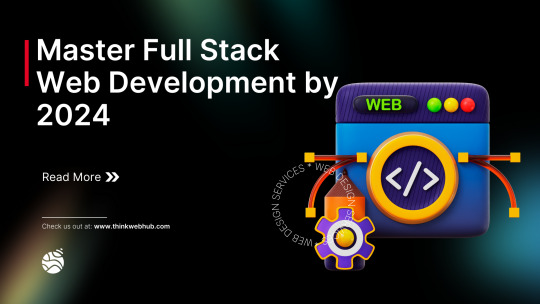
Your definitive guide to being a master in full-stack web development. Click here and find your potential now!
Introduction to Full Stack Web Development
Full Stack Web Development refers to full stack web development—the term that unites Front End and Back End technologies. It is the origination of web applications from ground zero, starting from design to development. Learning Full Stack in 2024 can open the doors to numerous opportunities in the industry.
Full Stack Web Development
Full Stack Developers: On the back and front end of software development lies the core demand. The dual value makes them a valuable asset to any development team. This also makes it easier to troubleshoot and ideate with a developer since the developer can plan according to both ends.
Essential Skills for Full Stack Developers
A full-stack developer should have a view of the frontend and backend technologies with industry knowledge.
Some of the Front-end Technologies include:
HTML/CSS: Building blocks of web development that structure and style a document.
JavaScript: Makes the web page dynamic and interactive.
Frameworks: Use React, Angular, or Vue.js to massively build your UI.
Some of the back-end technologies include:
Server-Side Languages: Python, Node.js, Ruby, and PHP.
Databases: SQL and NoSQL databases to manage data.
APIs: Capable of using RESTful and GraphQL APIs to communicate with many parts of the web application.
How you can become a full-stack developer in 2024
Start with the basics The basics of web development are HTML, CSS, and JavaScript. Make sure you have a grip on them first.
Learn front-end frameworks After understanding the basics, move on to front-end frameworks like React, Angular, or Vue.js. These tools help speed up the development process and enhance your capability to create complex user interfaces.
Learn a Back-End Language Choose any server-side language, such as Python, Node.js, or Ruby. Learn how to setup servers, manage databases, and create APIs. Building small projects can solidify your understanding.
Know About Databases Learn SQL and NoSQL databases with examples of actual databases, like MySQL, PostgreSQL, and MongoDB, respectively. Understanding how to store, retrieve, and manage data is very important when talking about full stack development.
Get Hands-On with Full Stack Projects Put your heads into full-fledged projects by building real small web applications. Hands-on learning from these projects will be very valuable. Start with straightforward projects and then gradually move into much more challenging projects.
Keep Updated with the Trends Web development is dynamic and observably so. To do this, read industry blogs, contribute to forums, and be part of online communities. Keeping abreast of changes to these trends will help you stay ahead of the game.
Tools and Resources to Learn
Online Courses There are online-based platforms like Coursera, Udemy, and freeCodeCamp that provide excellent courses on full stack web development.
Documentation and Tutorials Find the official documentation of any framework or language; it's the perfect one. Websites like MDN Web Docs and W3Schools also provide great tutorials.
Community Support Join online communities on Reddit, Stack Overflow, and GitHub. Engaging with other developers can provide support and inspiration.
Conclusion
It is an achievable goal to master full stack web development in 2024 by taking your time and using the proper resources. With knowledge of both front-end and back-end technologies, you will equip yourself well to build strong, efficient web applications. Begin today so as to unlock your potential in the tech world.
1 note
·
View note
Text
Hiring a React Developer: A Comprehensive Guide
In today’s digital landscape, having a strong online presence is essential for businesses of all sizes. One of the key components of a modern web application is a dynamic and responsive user interface (UI), which can significantly enhance user experience. React, a popular JavaScript library developed by Facebook, has become the go-to choice for building robust UIs. If you're looking to hire a React developer to take your web applications to the next level, this guide will help you understand what to look for and how to find the right candidate.
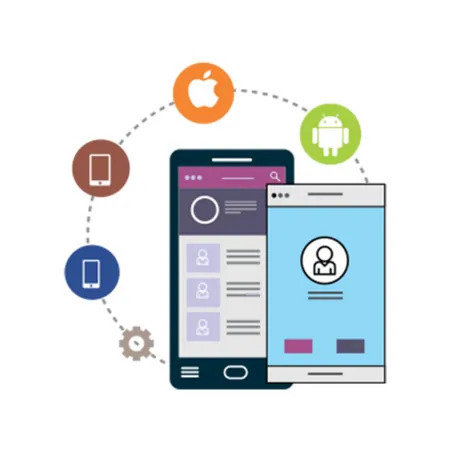
Why Hire a React Developer?
1. Popularity and Community Support
React has a vast and active community, which means there are plenty of resources, tutorials, and third-party libraries available. This community support ensures that React developers can find solutions to problems quickly and efficiently, reducing development time and costs.
2. Component-Based Architecture
React’s component-based architecture allows developers to build reusable UI components, leading to more maintainable and scalable code. This modular approach also facilitates easier updates and debugging.
3. Performance Optimization
React uses a virtual DOM (Document Object Model), which updates only the parts of the UI that need to be changed. This results in faster rendering and better performance, especially in complex applications with a lot of dynamic content.
4. SEO-Friendly
React can be rendered on the server side, which improves the SEO performance of your web application. This is crucial for businesses looking to improve their search engine rankings and increase organic traffic.
Key Skills to Look for in a React Developer
When hiring a React developer, it’s important to ensure they have the right skills and experience to meet your project’s needs. Here are some essential skills to look for:
1. Proficiency in JavaScript and ES6+
A strong understanding of JavaScript is fundamental for any React developer. They should be familiar with ES6+ features such as arrow functions, destructuring, spread/rest operators, and async/await.
2. Experience with React and JSX
Candidates should have hands-on experience with React, including knowledge of core concepts like state, props, lifecycle methods, and hooks. Additionally, they should be proficient in JSX, the syntax extension that allows HTML to be written within JavaScript.
3. Knowledge of State Management Libraries
State management is crucial in large React applications. Look for developers who are familiar with state management libraries such as Redux, MobX, or Context API.
4. Understanding of Component Lifecycle
A good React developer should understand the component lifecycle and how to manage side effects using lifecycle methods or hooks like useEffect.
5. Familiarity with RESTful APIs and GraphQL
Integration with backend services is a common requirement in React applications. Ensure the developer has experience working with RESTful APIs or GraphQL to fetch and manage data.
6. Testing and Debugging Skills
Testing is an integral part of the development process. Look for developers who are experienced with testing frameworks like Jest, Enzyme, or React Testing Library. They should also be proficient in debugging tools and techniques.
7. Version Control Systems
Knowledge of version control systems, particularly Git, is essential for collaboration and code management.
How to Find the Right React Developer
1. Define Your Requirements
Before starting the hiring process, clearly define your project requirements, including the scope, timeline, and specific skills needed. This will help you create a detailed job description and attract the right candidates.
2. Explore Multiple Hiring Platforms
To find the best talent, explore multiple hiring platforms such as job boards (Indeed, Glassdoor), freelancing websites (Upwork, Freelancer), and developer communities (GitHub, Stack Overflow). Networking through LinkedIn and attending tech meetups or conferences can also be effective.
3. Review Portfolios and GitHub Repositories
Reviewing a candidate’s portfolio and GitHub repositories can provide insights into their coding style, project experience, and problem-solving abilities. Look for clean, well-documented code and contributions to open-source projects.
4. Conduct Technical Interviews
Technical interviews are essential to assess a candidate’s skills and knowledge. Include questions on JavaScript fundamentals, React concepts, and problem-solving scenarios. Coding tests or live coding sessions can also help evaluate their practical skills.
5. Assess Soft Skills
In addition to technical expertise, assess the candidate’s soft skills such as communication, teamwork, and adaptability. These qualities are crucial for collaboration and successful project execution.
Conclusion
Hiring a React developer can significantly enhance the quality and performance of your web applications. By focusing on the right skills, exploring multiple hiring platforms, and conducting thorough interviews, you can find a developer who meets your project’s needs and contributes to your business’s success. Investing in a skilled React developer will ensure your web applications are dynamic, responsive, and user-friendly, ultimately leading to a better user experience and higher customer satisfaction.
0 notes
Text
Unlocking the Power of GraphQL: A Hands-On Tutorial for Efficient Data Fetching

Are you tired of dealing with bulky APIs that return more data than you need? Say hello to GraphQL, a game-changer in the world of web development! In this GraphQL tutorial, we'll explore how GraphQL simplifies data fetching and manipulation.
What is GraphQL?
GraphQL is a query language for your APIs. Unlike traditional RESTful APIs, where you're limited to predefined endpoints, GraphQL lets you request exactly the data you need, nothing more, nothing less.
How Does GraphQL Work?
Instead of multiple endpoints, GraphQL has a single endpoint where you can send queries to fetch data. These queries are structured in a way that matches your data's structure, making it incredibly flexible.
Getting Started with GraphQL
First, you'll need to set up a GraphQL server. Once that's done, you can define your schema, which describes your data's structure. Then, you can start writing queries to fetch the data you need.
Why Use GraphQL?
GraphQL simplifies data fetching by allowing clients to specify their exact data requirements. This reduces over-fetching and under-fetching, resulting in faster and more efficient applications.
Conclusion
With GraphQL, you have the power to shape your data fetching experience according to your needs. So why wait? Dive into the world of GraphQL and revolutionize your API experience today!
For more detailed insights into GraphQL, visit TutorialAndExample.com
0 notes
Text
Crafting Success: A Step-by-Step Guide to Start Your Full-Stack Developer Journey from Scratch
Absolutely! I’m thrilled to start the full-stack development journey alongside you. My proficiency in this field has notably expanded over time. Selenium has become a universally recognized and extensively utilized tool in various industries. Elevate your Full-Stack Developer career to new heights by joining a Top Institution in Chennai, such as ACTE Technologies.
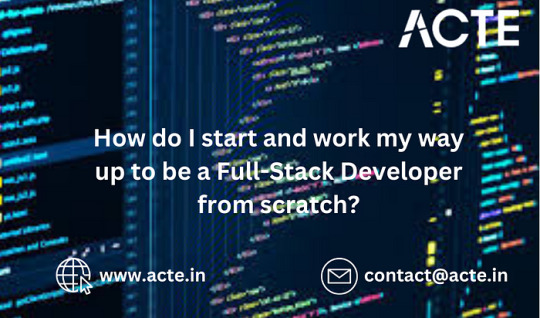
Embarking on the path to becoming a full-stack developer from scratch demands a methodical and determined approach.
Here’s A Step-By-Step Guide To Assist You In Commencing Your Journey and Progressing systematically:
1. Define Your Goals:
Clearly articulate your objectives and specify the technologies you aim to learn. Break down your goals into smaller, achievable milestones.
2. Learn the Basics:
Start with fundamental web development technologies: HTML, CSS, and JavaScript. Grasp the essentials of how browsers render web pages and the fundamentals of client-server communication.
3. Front-End Development:
Deepen your understanding of front-end technologies. Acquire proficiency in a front-end framework such as React, Angular, or Vue.js for crafting dynamic user interfaces.
4. Version Control:
Familiarize yourself with version control systems, especially Git. Leverage platforms like GitHub for collaborative work.
5. Back-End Development:
Choose a back-end language (e.g., JavaScript/Node.js, Python, Ruby, Java, PHP). Learn a corresponding back-end framework (e.g., Express.js, Django, Ruby on Rails, Spring Boot, Laravel).
6. Databases:
Develop expertise in both relational (e.g., PostgreSQL, MySQL) and NoSQL databases (e.g., MongoDB). Grasp the intricacies of database design and optimization.
7. APIs (RESTful and GraphQL):
Learn the process of designing, building, and consuming APIs. Explore both RESTful and GraphQL APIs for effective communication between front-end and back-end components.
8. Server Deployment and Cloud Services:
Acquire the skills to deploy applications to servers. Familiarize yourself with cloud services like AWS, Azure, or Google Cloud Platform.
9. Web Application Architecture:
Understand prevalent web application architectures. Explore client-server models, MVC/MVVM patterns, and microservices for a comprehensive understanding.
10. Testing and Debugging: - Master various testing techniques, encompassing unit testing, integration testing, and end-to-end testing. - Employ debugging tools to identify and rectify issues in the code.
11. Continuous Learning: - Stay abreast of the latest technologies and frameworks. - Engage actively with online communities, blogs, and tutorials.
12. Build a Portfolio: - Showcase your projects in a portfolio, encompassing both front-end and back-end work.
13. Networking: - Participate in meetups, conferences, and online communities to establish connections with fellow developers.
14. Freelancing and Open Source: - Contemplate contributing to open-source projects. - Undertake freelance projects to gain hands-on experience.
15. Soft Skills: - Develop effective communication, teamwork, and problem-solving skills. - Cultivate the art of time management for efficient workflows.
16. Job Search: - Utilize job search platforms and apply for entry-level positions or internships. - Tailor your resume and cover letter to highlight your unique journey and projects.
17. Continuous Improvement: - Solicit feedback on your work. - Continuously refine and expand your skill set in alignment with industry demands.
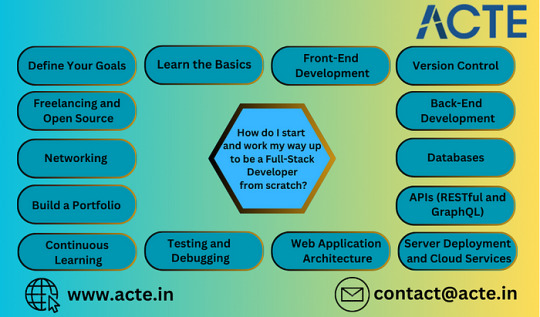
Remember, steadfast commitment, practical application, and an unwavering dedication to continuous learning are pivotal for triumphing on your expedition to becoming a full-stack developer from the ground up.
If you’re keen on exploring a Full-stack Developer course in Chennai, I highly recommend considering Top Institutions like ACTE Technologies. They provide certification programs and job placement opportunities, guided by experienced instructors to enhance your learning journey. These resources are available both online and in person. Enrolling in a course step by step could prove to be a valuable decision if it aligns with your interests.
I trust this addresses your query adequately. If you have more questions or need further clarification, please feel free to ask in the comments section.
If you’ve found this information valuable, I invite you to follow me on this platform and give it an upvote to encourage more discussions and insights about Full-stack Development. Your time and engagement are greatly appreciated, and I wish you a wonderful day ahead.
0 notes
Video
GraphQL Server in 4 Phases With Express & Typescript - JWT Auth Series Pt 1.
This video is a GraphQL server tutorial which covers GraphQL mutations, gives a GraphQLSchema example, and sets up a GraphQL Postgres db. We will be coding everything in Typescript and using Express/NodeJS for the build. Whether you're learning GraphQL for the first time or a seasoned coder, there are several nuggets of knowledge that you can get from this video.
#graphql server#graphql tutorial#graphql mutations#graphql typescript#express graphql#github graphql#graphql example#graphql js#graphql nodejs#npm graphql#nodejs graphql#howtographql#graphql npm#graphql postgres#graphql node#facebook graphql#postgres graphql#learning graphql#graphqlschema example#graphql db#graphqlerror#graphqlconfig#graphql postman#postman graphql#stack that code#graphql#graphql server tutorial#create a graphql server
1 note
·
View note
Video
youtube
Nodejs GraphQL API Project Tutorial for Microservice Developers | #graph... Full Video Link https://youtu.be/DXPxXJ7Qy7g Hello friends, new #video on #nodejs #graphql #api #microservices #tutorial for #api #developer #programmers with #examples is published on #codeonedigest #youtube channel. @java #java #aws #awscloud @awscloud @AWSCloudIndia #salesforce #Cloud #CloudComputing @YouTube #youtube #azure #msazure #restapi #nodejs #api #restapitutorial @codeonedigest #codeonedigest #graphqltutorial #graphql #javascript #graphqltutorialforbeginners #graphqlapireact #graphqlapicalls #graphqlapiproject #graphqlapinodejs #graphqlnodejstypescript #graphqlnodetypescript #graphqlnodejsreact #graphqlnodejsexpress #graphqlnodejsexpressexample #graphqlnodejsreact #nodejsgraphqlreact #graphqlserver #graphqltutorialapollo #graphqlapollo #graphqlapolloserver #graphqlapollotutorial #graphqlapollonodejs #apollographqlnodejs #api
#youtube#nodejs#graphql#nodejs tutorial#graphql tutorial#graphql schema#graphql query resolver#graphql resolver#graphql api#graphql server#graphql apollo server#apollo server#graphiql tool#graphiql api testing tool
1 note
·
View note
Text
How Web Design Newsletter
>>> Click here to subscribe and get the How Web Design newsletter sent to your inbox. <<<
____
Some of my favorite tutorials I've seen in the last month or so. — Craig Node.js Crash Course [Video] Explore Node.js fundamentals including modules such as path, url, fs, events and we will create an HTTP server from scratch without Express and deploy to Heroku. 100 Days Of Code Frontend Curriculum Day to day schedule for learning front-end development. Covers a wide range of front-end development topics, it can be thought of as more of a "survey" style course. WebFlow - Build, design, launch a website AD Build custom websites visually, manage projects in a shared dashboard, collaborate with your colleagues, then charge clients directly for ongoing costs right from Webflow. It’s the all in-one platform for growing agencies serving modern clients. Using CSS Grid the Right Way CSS Grid is robust, flexible, and a refreshing paradigm shift from other CSS layout systems. While these are selling points for Grid, they also make it hard to learn. A Detailed Guide to CSS Animations and Transitions The X-factor that makes these websites stands out. Animated CSS Burger Components Available as plain html/css or as React components. Fully functional WhatsApp Clone using React An open-source full-stack example app made with React 16.7 (Hooks & Suspense), TypeScript, GraphQL-Subscriptions/Codegen/Modules and PostgreSQL
____
Join 2861 other frontend web designers and UI/UX professionals to receive hand picked; design inspiration, tutorials, industry trends & updates — sent monthly.
310 notes
·
View notes
Text
Nodejs rest api

#Nodejs rest api full
At last you will learn to build serverless application using Node.js.
#Nodejs rest api full
Based on Apollo, our GraphQL plugin offers a full compatibility with the whole GraphQL. Later you will learn to test and verify API using Postman and set up API Gateway for the Rest API. You can use a standard RESTful API or GraphQL to query your content. It revolves around resource where every component is a resource and a resource is accessed by a common interface using HTTP standard methods. REST is web standards based architecture and uses HTTP Protocol. In this course, you will learn to set up Node.js, learn about important modules in Node.js, Events with Event loop and Event Emitter, Streams and stream pipes, after node you will learn about Express and Creating Rest API using express with both MySQL and MongoDB. Node.js - RESTful API Advertisements Previous Page Next Page What is REST architecture REST stands for REpresentational State Transfer. At last creating and deploying serverless project on AWS Lambda. Integrating Gateway to route the request and keep track of everything. STEP-1: Create a separate folder and with the help of a terminal or command prompt navigate to this folder: STEP-2: Create package.json by typing the following command in the terminal: npm init -y. Postman is an API testing tool and gives wide support for all possible HTTP methods. It will show the installed version of NodeJs to our system as shown in the below screenshot. Create and configure middleware to add things like logging, authentication and authorization, and other web. Express is a node.js web application framework and MySQL, MongoDB are databases used to manage data. A RESTful API is an Application Programming Interface (API) that uses HTTP verbs like GET, PUT, POST, and DELETE to operate data. Use Express for Node.js to build RESTful APIs. In this course, you will set up Node.js and create Rest API using express with both MySQL and MongoDB and test it using Postman. For now, let’s start creating our secure REST API using Node.js In this tutorial, we are going to create a pretty common (and very practical) REST API for a resource called users. Node.js uses an event-driven, non-blocking I/O model that makes it lightweight and efficient, perfect for data-intensive real-time applications that run across distributed devices. It is used for building fast and scalable network applications. Node.js is a server-side platform built on Google Chrome's JavaScript Engine. If you are going to create the routes in a simple and easy manner with out much understanding much about node js framework, you can go with Express JS.

0 notes
Text
Migrate from REST to GraphQL Seamlessly
1. Introduction Migrating an existing REST API to GraphQL can seem daunting, but it offers significant benefits such as improved performance, better data control for clients, and reduced overhead. This tutorial will guide you through the process, helping you understand the technical underpinnings and practical implementation steps. What You Will Learn: – How to set up a GraphQL server – How to…
0 notes
Text
July 26, 2018
News and Links
Protocol (with an assist from the Ethereum Research team)
Shasper chain, v2.1
Prysmatic’s biweekly update on transitioning to Eth 2.0 with separate Go codebase
VDFs are not Proof of Work by Danny Ryan. Verifiable Delay Functions have some properties - requiring significant computation to calculate but relatively little computation to verify - that is suitable for strengthening RANDAO-based RNG. That sounds like proof of work, but Danny explains the difference between VDFs and PoW.
STARKs, Part 3: Into the Weeds by Vitalik Buterin: In Vitalik’s STARKs series part 3, he introduced how to actually implement a STARK with vivid explication.
Latest Casper standup call
VB: Epoch-less Casper FFG liveness/safety argument
Why Shasper makes more sense than the previous FFG, then sharding roadmap
LearnPlasma is really coming together as a Plasma education resource
A Plasma Cash primer from Simon de la Rouviere
Jinglan Wang: what is Plasma? Plasma Cash?
Raiden is live on Ropsten testnet and open to testing
Stuff for developers
Benchmarking between Mythril, Manticore and Oyente from ConsenSys Diligence
What FoMo3d’s real exit scam might look like, but you can hedge with Augur?
Péter Szilágyi: How to PWN FoMo3D, a beginners guide
Pipeline - video explaining PoC of visual IDE of already deployed functions
Airswap tutorial on building with their API server
Adding ENS into your dapp tutorial
Tutorial to using Parity’s Secret Store multi-party key generation
IDEO on dealing with gas in UX
ethereum-to-graphql: autogenerate the schema and resolver
EthQL alpha from PegaSys and Infura
Aragon Package Manager - upgradeability for Aragon orgs
Zeppelin: Exploring upgradeability governance in ZeppelinOS with a Gnosis MultiSig
Apache Camel connector for Ethereum enterprise using web3j
The new Infura dashboard - existing access tokens need to migrate to v3 authentication keys and endpoints
Release
Trinity v0.1.0-alpha.12, better syncing and performance. Also has a new website.
web3j v3.5
web3.js 0.20.7 and web3.js 1.0.0-beta.35. breaking change on http provider
EthereumJS VM v2.4.0 (and their monthly recap)
Live on mainnet
iExec went live on mainnet to test rendering. 80% of jobs completed.
Melonport is live on mainnet with somewhat constrained Paros release
Gnosis DutchX contracts are live on mainnet in advance of their 100k competition to build on them
Ecosystem
The new Gnosis Safe miltisig is live on Rinkeby
Parity’s Thibaut Sardan: what is a light client and why should you care?
Someone managed to briefly cause a kerfuffle with a 1337 Javascript popup in Etherscan using their Disqus comments.
Nathan Sexer: State of stablecoins
Metamask’s retrospective on getting removed from the Chrome store this week. Also how they’ll support more networks
A reader friendly version of 100+ Eth dev interviews from EthPrize
Governance and Standards
EIP1227 (remove difficulty bomb, revert to 5 ETH block reward) vs EIP1234 (delay difficulty bomb, reduce to 2 ETH block reward) vs EIP1240 (remove difficulty bomb, leave at 3 ETH block reward). Results in Afri’s poll mirror what I hear in the community.
ERC1257: proof of payment standard
ERC1238: non-transferrable token badges
ERC1261: membership verification token
Add bottom-up composables to ERC998
ERC1263: NFT index
Project Updates
As planned, Augur burned the escape hatch, so the code is now decentralized.
Messari buys OnchainFX, lays out content strategy
Status now displays at full resolution on tablets, and no more Mixpanel
Maker to vote on increasing the Dai stability fee to 2.5%
Interviews, Podcasts, Videos, Talks
Dappcon videos are coming in
Andy Tudhope talks about EthPrize’s dev interviews on Smartest Contract
CoinTelegraph with some good print interviews: Jutta Steiner and Joe Lubin
FunFair’s Jez San podcast interview
Open Source Web3 Design call
Jay Rush talking The Dao and how Quickblocks grew out of that from Gitcoin’s weekly stream
Dan Boneh on the Bitcoin Podcast
Ethan Buchman talks testnets on Zero Knowledge
Dan Finlay on MetaMask and Mustekala on Smartest Contract
Maker’s Rune Christensen print interview where he says they are developing their own language for better security
Martin Becze on Epicenter
Tokens
You now need Santiment tokens to access some of their market and data feeds.
Text tutorial of how to claim your (free) Livepeer tokens.
Incentivizing new users of TCRs through gamification
Mike Maples: Slow money crypto
General
Zilliqa releases its Scilla language “with formalization of its semantics and its embedding into Coq.” Also of interest, Etheremon is planning to have gameplay on Zilliqa but will use Ethereum as its store of value.
First Polkadot parachain deployed in PoC2
Raul Jordan with an intro to hashing algos
NYTimes on art and blockchain
Péter Szilágyi: TOR from within GO. I imagine many who read it will immediately start using the Brave browser’s private tabs with TOR
Ethereum coming to Google Cloud
John Backus with his lessons learned from p2p file sharing
Dates of Note
Upcoming dates of note:
August 7 - Start of two month distributed hackathon from Giveth, Aragon, Swarm City and Chainshot
August 10-12 - EthIndia hackathon (Bangalore)
August 10-12 - ENS workshop and hackathon (London)
August 22 - Maker DAO ‘Foundation Proposal’ vote
August 24-26 - Loom hackathon (Oslo, Norway)
September 6 - Security unconference (Berlin)
September 7-9 - EthBerlin hackathon
September 7-9 - WyoHackathon (Wyoming)
September 8 - Ethereum Industry Summit (Hong Kong)
Oct 5-7 - TruffleCon in Portland
Oct 5-7 - EthSanFrancisco hackathon
Oct 11 - Crypto Economics Security Conf (Berkeley)
Oct 22-24 - Web3Summit (Berlin)
Oct 26-28 - Status hackathon (Prague)
Oct 29 - Decentralized Insurance D1Conf (Prague)
Oct 30 - Nov 2 - Devcon4 (Prague)
Dec 7-9 - dGov distributed governance conf (Athens)
December - EthSingapore hackathon
If you appreciate this newsletter, thank ConsenSys
This newsletter is made possible by ConsenSys, which is perpetually hiring if you’re interested.

Editorial control is 100% me. If you're unhappy with editorial decisions, feel free to tweet at me.
Shameless self-promotion
Link: http://www.weekinethereum.com/post/176336020338/july-26-2018
Most of what I link to I tweet first: @evan_van_ness
Did someone forward this email to you? Sign up to receive the weekly email (box in the top blue header)
1 note
·
View note
Photo

Tutorial: Create an Ethereum GraphQL Server with Node.js ☞ https://medium.com/dev-red/create-an-ethereum-graphql-server-with-node-js-part-2-9cf52b4b0099 #nodejs #GraphQL
1 note
·
View note
Text
Mastering the Code: A Step-by-Step Guide on How to Become a Self-Taught Full Stack Developer
Certainly! I’m excited to delve into the world of full-stack development with you. My expertise in this field has grown significantly over time. Selenium has emerged as a widely acknowledged and extensively utilized practice spanning various industries. Advance your career in Full-Stack Developer at a Top Institution in Chennai, like ACTE Technologies.
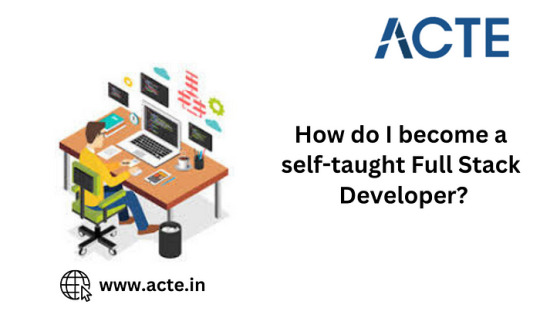
Embarking on the journey to become a self-taught full-stack developer requires a structured and disciplined approach.
Here’s A Step-By-Step Guide To Help You Navigate This Path:
1. Set Clear Goals:
Define your objectives and identify specific technologies you want to learn. Break down your goals into manageable milestones.
2. Learn the Basics:
Start with fundamental web development technologies: HTML, CSS, and JavaScript. Understand how browsers render web pages and the basics of client-server communication.
3. Front-End Development:
Dive deeper into front-end technologies. Learn a front-end framework like React, Angular, or Vue.js to build dynamic user interfaces.
4. Version Control:
Familiarize yourself with version control systems, especially Git. Use platforms like GitHub for collaboration.
5. Back-End Development:
Choose a back-end language (e.g., JavaScript/Node.js, Python, Ruby, Java, PHP). Learn a corresponding back-end framework (e.g., Express.js, Django, Ruby on Rails, Spring Boot, Laravel).
6. Databases:
Gain proficiency in both relational (e.g., PostgreSQL, MySQL) and NoSQL databases (e.g., MongoDB). Understand database design and optimization.
7. APIs (RESTful and GraphQL):
Learn how to design, build, and consume APIs. Explore both RESTful and GraphQL APIs.
8. Server Deployment and Cloud Services:
Learn how to deploy applications to servers. Familiarize yourself with cloud services like AWS, Azure, or Google Cloud Platform.
9. Web Application Architecture:
Understand common web application architectures. Learn about client-server models, MVC/MVVM patterns, and microservices.
10. Testing and Debugging: - Master testing techniques and use debugging tools to ensure code reliability.
11. Continuous Learning: - Stay updated with the latest technologies and frameworks. - Engage with online communities, blogs, and tutorials.
12. Build a Portfolio: - Create a portfolio showcasing your projects. Include both front-end and back-end work.
13. Networking: - Attend meetups, conferences, and join online communities to connect with other developers.
14. Freelancing and Open Source: - Consider contributing to open-source projects. - Take on freelance projects to gain practical experience.
15. Soft Skills: - Develop communication, teamwork, and problem-solving skills. - Practice effective time management.
16. Job Search: - Utilize job search platforms and apply to entry-level positions or internships. - Tailor your resume and cover letter to highlight your self-taught journey and projects.
17. Continuous Improvement: - Seek feedback on your work. - Keep refining and expanding your skill set based on industry demands.

Remember, the path to becoming a self-taught full-stack developer is a gradual process, and consistent practice, real-world projects, and continuous learning are key to success.
If you’re keen on exploring a Full-stack Developer course in Chennai, I highly recommend considering Top Institutions like ACTE Technologies. They provide certification programs and job placement opportunities, guided by experienced instructors to enhance your learning journey. These resources are available both online and in person. Enrolling in a course step by step could prove to be a valuable decision if it aligns with your interests.
I trust this addresses your query adequately. If you have more questions or need further clarification, please feel free to ask in the comments section.
If you’ve found this information valuable, I invite you to follow me on this platform and give it an upvote to encourage more discussions and insights about Full-stack Development. Your time and engagement are greatly appreciated, and I wish you a wonderful day ahead.
0 notes